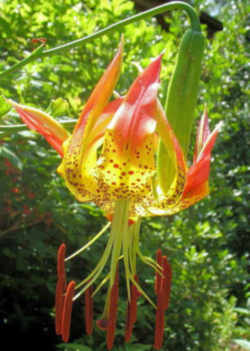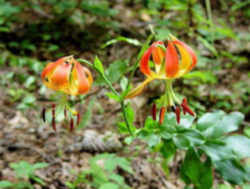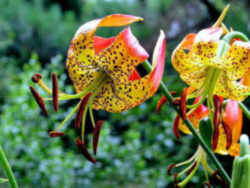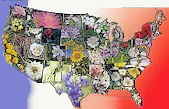
North Carolina Symbols
North Carolina State Wildflower
Carolina Lily

(Lilium michauxii)
Adopted in 2003.
In 2003, the General Assembly designated the Carolina Lily, (Lilium michauxii,) as the official State wildflower (Session
Laws, 2003, c. 426).
Named for Andre Michaux, a noted eighteenth century naturalist and explorer, this flower grows throughout the state, from the forests and hills of Cherokee County to the coastal swamplands (pocosins) of Hyde and Pamlico counties.
A North Carolina highway historical marker now stands in Michaux's honor on State Street in Black Mountain. Another posthumous honor for Michaux came in 2003, when the N.C. General Assembly officially adopted the Carolina lily as the state's wildflower.
Lilium michauxii, commonly known as the Carolina lily can be found in the Southeastern United States from West Virginia in the north to Florida in the south to Texas in the west, and can bloom as late as October, though it is most prevalent in July and August
It's often mistaken for another plant, the Turk's-cap lily (Lilium superbum). The two appear similar, but there's a sizable difference. While our Carolina lily (Lilium michauxii) grows two to three feet tall and bears about four flowers, the Turk's-cap lily can grow up to three times taller and bear more than twice as many flowers. Since both of these plants bloom primarily in July and August, use careful judgment when trying to identify a Carolina lily.
Description of the North Carolina State Wildflower: Carolina Lily

Lilium michauxii, commonly known as the Carolina lily can be found in the Southeastern United States from West Virginia in the north to Florida in the south to Texas in the west. It is most common in the summer months of July and August but can be found blooming as late as October. It was named for the French botanist Andre Michaux, who travelled and did research throughout the Southeast.
The common name "Carolina lily" reflects an older taxonomy that used the name Lilium carolinianum for both L. michauxii and L. catesbaei. Another common name, Turk's cap lily, has been listed for L. michauxii, although L. superbum (which is very similar in appearance to L. michauxii) shares this common name.

The Carolina Lily is a scarce and exciting flower that can be found in dry woods in July and August. It has one to six blossoms at the summit of its stem. This magnificent flower is yellow to reddish-orange, spotted with brown. The six tepals (3 petals and 3 sepals) are strongly reflexed (bent back), and six slender filaments topped by brown anthers protrude from the center of the flower, as does a long style with a three-lobed stigma. Each nodding flower is about three inches in diameter. The stem can grow up to 4 feet high, and can have up to 6 flowers at the summit, though 1-3 are more common. The petals are brilliant red-orange with brown spots, and arched back so that the tips overlap.
For several weeks between May and August, the Carolina lily presents a wonderful display of drooping flowers that are characterized
by their half dozen reddish-yellow reflexed petals with spots at the base. The whorled obovate leaves of L. michauxii
distinguish it from similar species which feature lanceolate leaves.
The anthers of the Carolina lily boast copious amounts of brownish-burgundy pollen, but self-fertilization is impossible due to a flower's ability
to reject its own pollen. Pollination is dependent upon insects, particularly bees and bumblebees, which transfer pollen from one flower to another.
The lily comes from a scaly bulb and can be propagated by scale division or by seed. It is an attractive plant and worthy of cultivation. Plant in a well-prepared soil with plenty of organic matter worked into it. Several hours a day of sunlight are necessary for blooms.
Carolina Lily Fact Sheet:
Life Cycle: Perennial
Height: 2 to 3 feet
Flower/fruit: 1 to 3 orange flowers; does not have a central green star; petals bent backward
Flowering Season: Summer
Foliage: Whorled, thick, fleshy leaves taper to a blunt point; widest above the middle
Site: Upland pine oak woods
North Carolina Law
The law designating Carolina Lily as the official North Carolina state wildflower is found in the North Carolina General Statutes, Chapter 145 Section 145-20.
CHAPTER 145. State Symbols and Other Official Adoptions.
SECTION 145-1.
§ 145-20. State wildflower.
The Carolina Lily (Lilium michauxii) is adopted as the official wildflower of the State of North Carolina. (2003-426, s. 1.)
Taxonomic Hierarchy: Carolina Lily
Kingdom: Plantae - Plants
Subkingdom: Tracheobionta - Vascular plants
Superdivision: Spermatophyta - Seed plants
Division: Magnoliophyta - Flowering plants
Class: Liliopsida - Monocotyledons
Subclass: Liliidae
Order: Liliales
Family: Liliaceae - Lily family
Genus: Lilium L. - lily
Species: Lilium michauxii Poir. - Carolina lily
State Floral Emblems







